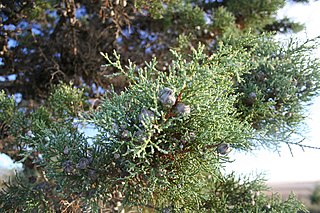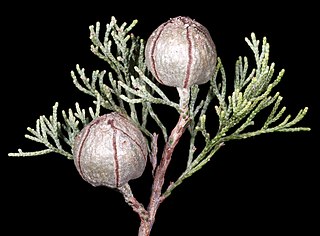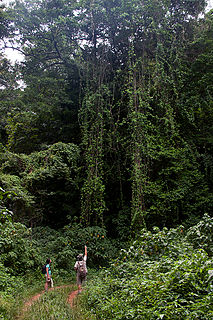
The International Union for Conservation of Nature (IUCN) Red List of Threatened Species, founded in 1964, is the world's most comprehensive inventory of the global conservation status of biological species. It uses a set of precise criteria to evaluate the extinction risk of thousands of species and subspecies. These criteria are relevant to all species and all regions of the world. With its strong scientific base, the IUCN Red List is recognized as the most authoritative guide to the status of biological diversity. A series of Regional Red Lists are produced by countries or organizations, which assess the risk of extinction to species within a political management unit.

Cypress is a common name for various coniferous trees or shrubs of northern temperate regions that belong to the family Cupressaceae. The word cypress is derived from Old French cipres, which was imported from Latin cypressus, the latinisation of the Greek κυπάρισσος (kyparissos).

Strychnos is a genus of flowering plants, belonging to the family Loganiaceae. The genus includes about 100 accepted species of trees and lianas, and more than 200 that are as yet unresolved. The genus is widely distributed around the world's tropics and is noted for the presence of poisonous indole alkaloids in the roots, stems and leaves of various species. Among these alkaloids are the well-known and virulent poisons strychnine and curare.
Juniperus indica, the black juniper, is a juniper native to high-altitude climates in the Himalaya, occurring in Pakistan, India, Nepal, Bhutan and China.

The conservation status of a group of organisms indicates whether the group still exists and how likely the group is to become extinct in the near future. Many factors are taken into account when assessing conservation status: not simply the number of individuals remaining, but the overall increase or decrease in the population over time, breeding success rates, and known threats. Various systems of conservation status exist and are in use at international, multi-country, national and local levels as well as for consumer use.

Cupressus bakeri, reclassified as Hesperocyparis bakeri, with the common names Baker cypress, Modoc cypress, or Siskiyou cypress, is a rare species of cypress tree endemic to a small area across far northern California and extreme southwestern Oregon, in the western United States.

An IUCN Red List Critically Endangered (CR) species is one that has been categorized by the International Union for Conservation of Nature as facing an extremely high risk of extinction in the wild. As of 2021, of the 120,372 species currently tracked by the IUCN, there are 6,811 species that are considered to be Critically Endangered.

Callitris canescens is a species of conifer in the family Cupressaceae. It is found only in Australia.
Juniperus barbadensis is a species of conifer in the family Cupressaceae. It is native to the Bahamas, Cuba, Jamaica, and Saint Lucia.
Juniperus pingii is a species of conifer in the family Cupressaceae. Commonly used in bonsai, it can produce and correct proportional miniature version of the full size tree. It is native only to China.

Helicia is a genus of 110 species of trees and shrubs, constituting part of the plant family Proteaceae. They grow naturally in rainforests throughout tropical South and Southeast Asia, including India, Sri Lanka, Indochina, Peninsular Malaysia to New Guinea and as far south as New South Wales.
Strychnos benthami is a species of plant in the Loganiaceae family. It is endemic to Sri Lanka.
Strychnos chromatoxylon is a species of plant in the Loganiaceae family. It is found in Cameroon, Central African Republic, and Ivory Coast.
Strychnos elaeocarpa is a species of plant in the Loganiaceae family. It is endemic to Cameroon. Its natural habitat is subtropical or tropical moist lowland forests. It is threatened by habitat loss.
Strychnos millepunctata is a species of shrub or small tree in the Loganiaceae family. It is endemic to Côte d'Ivoire and grows in the lowland Eastern Guinean forests where it is threatened by habitat loss. S. millepunctata has been investigated for pharmacological properties of its alkaloids.
Strychnos staudtii is a species of plant in the Loganiaceae family. It is found in Cameroon and Gabon. Its natural habitat is subtropical or tropical moist lowland forests. It is threatened by habitat loss.
Strychnos tetragona is a species of plant in the Loganiaceae family. It is endemic to Sri Lanka.
Grevillea molyneuxii, commonly known as the Wingello grevillea, is a shrub which is endemic to the shrublands of New South Wales in Australia.

The 950 hectares Chirinda Forest Botanical Reserve is situated on the slopes of Mount Selinda, 30 km south of Chipinge, in the Chipinge Highlands of Manicaland, Zimbabwe, and is administered by the Forestry Commission. The reserve is situated at between 900 and 1,200 m in altitude, and receives some 1,370 mm (54 in) to 1,466 mm (57.7 in) of annual rainfall. 606 hectares of its higher levels, above 1,076 m (3,530 ft), is covered by moist evergreen forest, specifically Zanzibar-Inhambane transitional rain forest, of which it represents the southernmost occurrence. The headwaters of three streams, namely the Zona, Chinyika and Musangazi, drain the two broad highlands which it encloses. The boundaries of the reserve are not strictly enforced, so that cattle grazing and plant harvesting are ongoing. The reserve is surrounded by communal settlements, commercial timber plantations and small-scale commercial farming units. The naturalist Charles Swynnerton was appointed manager of the nearby Gungunyana farm in 1900, and a number of plant, bird and insect names commemorate his collecting activities of the next two decades. Chirinda means "lookout" or "vantage point" in the chiNdau language, or perhaps "place of refuge".








